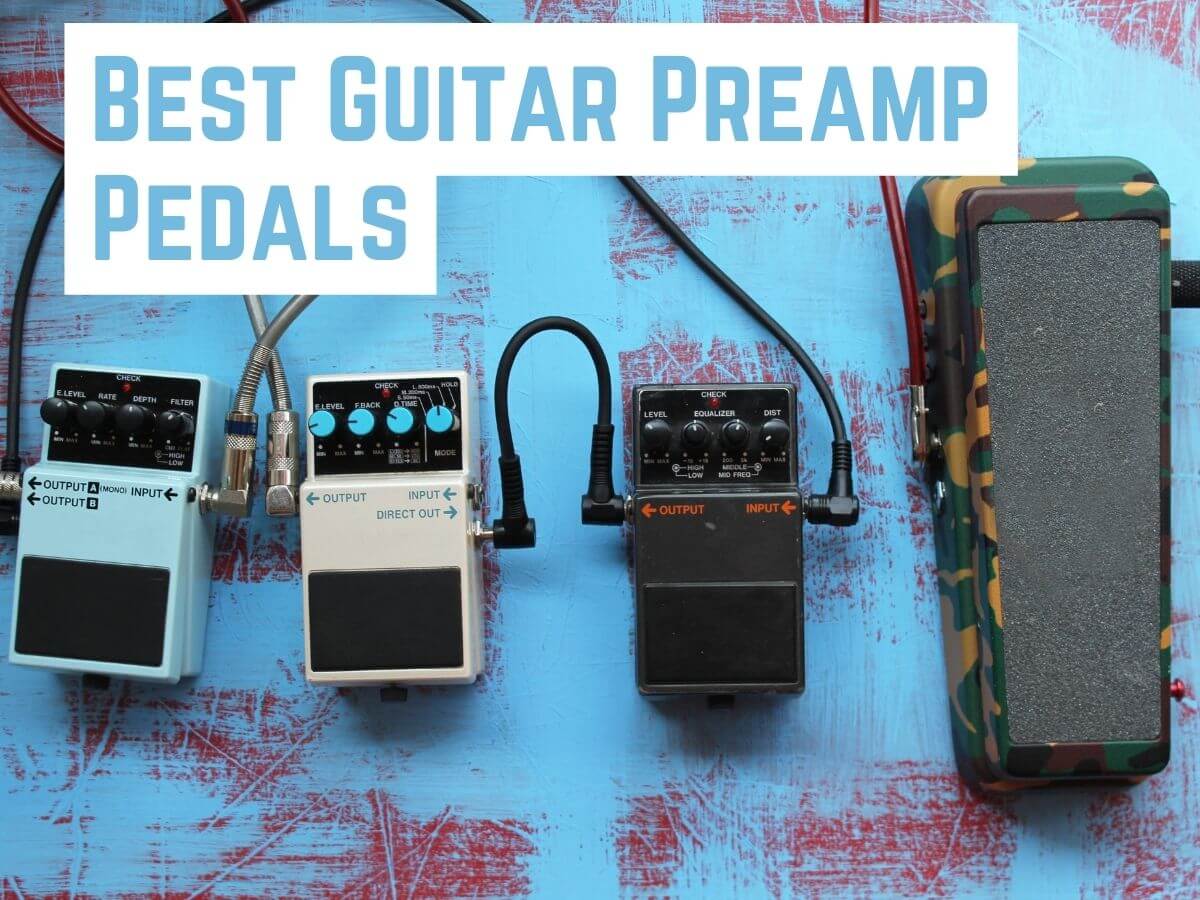
Preamp pedals have made life easier for guitarists for several years now; they let us benefit from the sound of vintage tube amps in compact stompbox units.
Preamp technology has advanced a lot as well, and so we decided to compare the best guitar preamp pedals available in the market today, so that you can pick the one that’s right for you.
What are the Best Guitar Preamp Pedal?
1. JHS Pedals Colour Box V2 Preamp Guitar Effects Pedal – Best Overall
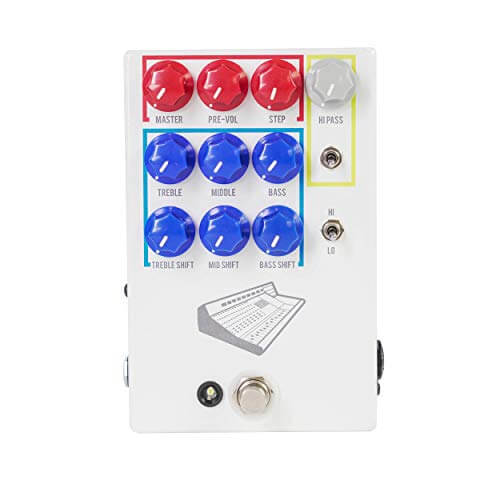
Specifications
- Suitable For: All
- Cab Sim: No
- Controls: Master, Pre-Vol, Step, Treble, Middle, Bass, Treble Shift, Mid Shift, Bass Shift, Hi-Pass, Hi/Lo Switch
- Power: 9V DC PSU
- Bypass: True
JHS has been innovating new pedals and redesigning many classic effects for several years now, with great success. The original Color Box was a big success, having been used by bands like U2 and Muse. Now, they’ve updated it and launched the Color Box V2, with many significant improvements across the board.
The Color Box is not simply a guitar preamp, it works well for any instrument. It was designed to produce that ‘direct-in’ tone used by many classic bands, like The Beatles, which was based on the NEVE 1073 preamp circuit. And this pedal accomplishes that beautifully. There are 9 control knobs on front that let you control your signal articulately, with a 3-band EQ with individual shift knobs, and gain that goes up to +39 dB.
There’s a toggle switch for the headroom, so you can have either ultra-clean tones or even distorted, fuzz tones. There’s a Hi-Pass function as well as a -20dB pad function if needed. It can provide 48V phantom power to condenser mics and drives acoustic guitars with 100% clean signals as well. According to guitarist Pete Thorn :
It’s a really unique tone-shaping tool with overdrive and fuzz, making it a great and very cool pedal.
The Color Box is quite compact and durable, and can easily fit on pedalboards. It has a combo input jack for both guitars and microphones, with a selector switch on the side. It has a true bypass, an LED to show the power state, and it requires a 9V DC, centre-negative power supply to function properly.
If you want the best guitar preamp pedal with a lot of room for flexibility and customization, with superb tones on every setting, then you should get the JHS Color Box V2. With extensive control over its preamp and EQ section, a classic tone used by many rock legends, amazing versatility with different instruments, and a compact stompbox format, this is a pedal that deserves to be on any musician’s rig.
2. Donner Incredible V Mini Preamp – Budget Pick
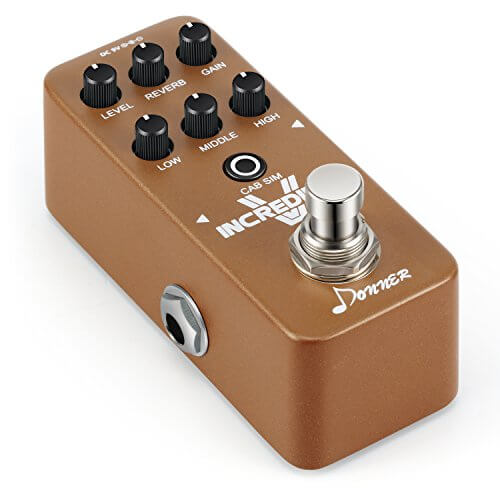
Specifications
- Suitable For: Electric Guitar
- Cab Sim: Yes
- Controls: Level, Reverb, Gain, Low, Middle, High, Cab Sim
- Power: 9V DC PSU |
- Bypass: True
Donner pedals have gained a lot of popularity amongst budding musicians recently for their range of high-quality, compact, and affordable guitar pedals. They have a range of mini preamps, and we’ve chosen the Incredible V as it combines two iconic guitar amplifier models in a single pedal with remarkable quality at a competitive price.
The Incredible V has six knobs on its front that control Level, Reverb, Gain, Low, Middle, and High. With the built-in reverb and 3-band EQ, you can save some space on your pedalboard for other pedals. But the remarkable aspect of this pedal is that it has two amp models inside it: A Fender 65 Twin Reverb, and a Marshall Super Lead 1959, each with its own cabinet sim and preset settings.
This gives you access to a range of tones at the touch of a button, from crystal cleans to dirty crunch tones like Jimmy Page, all in a really compact stompbox. Donner has managed to emulate the tones of those amps very well, and with the EQ and reverb, you can customize your tone even further as you wish.
The Incredible V is a mini guitar preamp pedal, with a very compact yet durable metal chassis that’ll easily go anywhere you go. The Cab Sim button has an LED around it to show its current status. It requires a 9V DC power supply, and it has true bypass.
If you’re looking for a great compact preamp pedal on a budget, you can’t go wrong with the Donner Incredible V mini preamp pedal. With two classic amp models with a cabinet simulator, built-in reverb, easy to use controls, and a durable chassis, this pedal is an amazing product for its price, and will help you build your tone more effectively.
3. MOOER PreAMP Live – Most Versatile
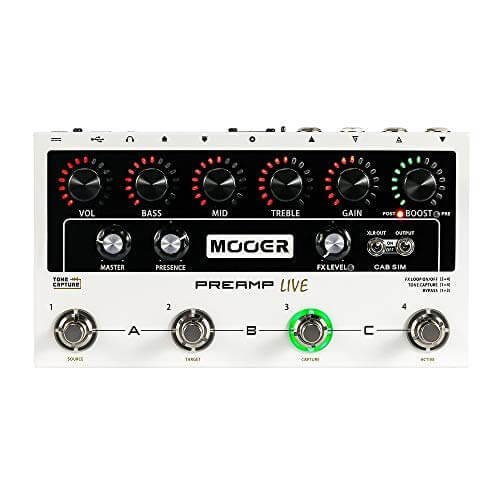
Specifications
- Suitable For: Electric And Bass Guitar
- Cab Sim: Yes
- Controls: Volume, Bass, Mid, Treble, Gain, Boost, Master, Presence, FX, Cab Sim, A/B/C/D Footswitches
- Power: 9V-12V DC PSU
- Bypass: Buffered
Mooer has been manufacturing a range of preamp and effects pedals that offer very high-quality reproductions of classic analog units at affordable prices. Recently, they launched the Preamp Live, which is an amp modeller unit with over 12 preamps accessible together, complex routing capabilities, cab sims, and even more functionality through the mobile app.
The Preamp Live has 6 main knobs on its front, each with its own LED ring, that control Volume, Bass, Mid, Treble, Gain, and Boost. Besides these, there are Master Volume, Presence, and FX Level knobs, along with a Cab Sim switch. There are four footswitches at the bottom, much like a multi-fx unit, and each has its own LED ring. These control 3 banks of 4 preamps, giving you instant access to 12 preamps at any given time.
The Preamp Live offers a ton of versatility. Mooer offers over 50 guitar amp models to choose from, with more added in firmware updates. With the custom IR loader, you can load your own impulse responses, and with the ‘Tone Capture’ function, you can even capture your amp’s tone and save it in the pedal. By connecting it to the mobile or desktop app, you can configure its settings even deeper, fine-crafting your tone as you see fit.
If you want a multi-preamp pedal that competes with some of the best units like the Axe-FX and Helix at an affordable price, then you should definitely check out the Mooer Preamp Live. With extensive customizability, a plethora of vintage amps for both guitar and bass that sound faithful to the originals, easy to use controls, superb routing options and connectivity, and mobile connectivity, Mooer is pushing the boundaries of modern technology to its finest.
4. Fishman Aura Spectrum DI Acoustic Preamp Pedal – Best For Acoustic Guitar
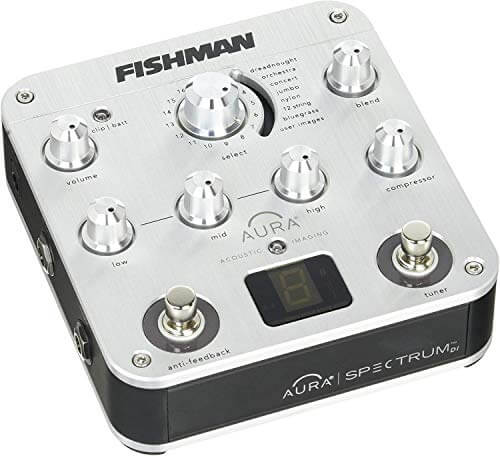
Specifications
- Suitable For: Acoustic Guitar
- Cab Sim: Yes
- Controls: Volume, Mode, Blend, Low, Mid, High, Compressor, Anti-Feedback, Tuner
- Power: 9V PSU or Battery
- Bypass: True
Fishman is a well-known name in the industry for their high-quality guitar pickups and acoustic technology. Their Aura series of acoustic guitar processors have been equally well-received, and now they’ve updated it with the Aura Spectrum DI, an acoustic preamp pedal which features their signature Aura Acoustic Imaging Technology that can completely transform the sound of your acoustic guitar.
The Fishman Aura has 128 preloaded images on the pedal, with more expandable through the Image Gallery app on the desktop. These can be selected on the basis of the size and type of your guitar, such as dreadnought, concert, 12-string, etc. Each type has a further 16 images that can be selected from, each painfully recreated using studio miked amplifiers and PAs. This results in not only a lot of versatility, but beautiful, authentic acoustic tones.
The Aura also features a full-metal chassis that’s designed for touring. With its compact size, it’s easy to carry, and it has an onboard 3-band EQ, compressor, and tuner, along with anti-feedback technology to prevent resonances. It can be bypassed when not needed, and it requires a 9V power supply or battery to function.
If you want a one-stop acoustic preamp and imaging solution for your acoustic guitar, then get the Fishman Aura Spectrum DI acoustic preamp pedal. This is a pedal that completely transforms your acoustic’s sound, and with the built-in EQ, compressor, tuner, DI, and anti-feedback, along with USB connectivity for more images, it offers a world of acoustic tones from a single pedal, making it the best guitar preamp pedal for acoustic musicians.
5. Darkglass Electronics Microtubes B7K Ultra V2 Distortion/Bass Preamp Effects Pedal – Best For Bass Guitar
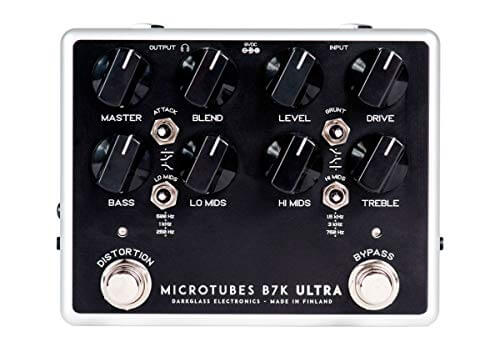
Specifications
- Suitable For: Bass Guitar
- Cab Sim: Yes
- Controls: Master, Blend, Level, Drive, Bass, Lo Mids, Hi Mids, Treble, Grunt, Attack, Distortion
- Power: 9V DC PSU
- Bypass: Buffered
Darkglass Electronics have made a name for themselves for their premium, high-quality analog bass pedals and gear. All of their pedals are handmade, with exceptional attention to detail and top-notch build quality. They have a range of Microtubes bass pedals, but the Microtubes B7K Ultra is one of their best-selling ones, and offers a whole range of bass tones from a single pedal.
The B7K Ultra was recently updated to V2, with even more added features. It now has a 4-band EQ that lets you adjust Bass, Lo Mids, Hi Mids, and Treble, with center frequency switches for the Lo and Hi Mids region. There’s a Master volume control, a Blend knob, and a Level control, that lets you fine-tune your overdrive saturation and levels accordingly, and the Drive knob, along with the Grunt and Attack switches control the gain and distortion.
The main new feature on the B7K Ultra is the addition of a single, user loadable cab sim. It comes with an amazing factory cab sim that’s versatile for many genres as it is, but with the Darkglass Suite software, you can customize it and load any cab sim you want, giving you full control over your tone. Here’s what legendary bassist Adam ‘Nolly’ Getgood had to say about it:
The inclusion of cabinet simulation takes the B7K Ultra from already being an awesome product, to being a truly deadly one.
Being handmade, the B7K Ultra features a premium metal chassis and looks gorgeous; a fine addition to any bassist’s pedalboard. Besides the input and output jacks, it also features a ground lift switch to ensure there aren’t any ground loops, an XLR Direct Output, a headphone jack, and a USB port to connect it to a desktop. It requires a 9V power supply for operation, and it has a buffered bypass.
If you want a versatile bass preamp for your bass guitar, then the Darkglass Electronics B7K Ultra is your best option. With a 4-band EQ, an amazing distortion preamp, a host of controls to fine-tune your sound, a custom cab simulator option, and a premium handmade design, it’s simply the best guitar preamp pedal for bass guitars for both live and studio use.
6. Voodoo Lab Giggity Analog Mastering Preamp Guitar Effect Pedal
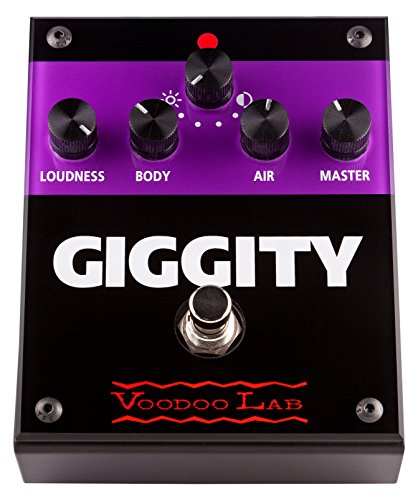
Specifications
- Suitable For: Electric And Acoustic Guitar
- Cab Sim: No
- Controls: Loudness, Body, Air, Master, Sun/Moon
- Power: 9V DC PSU or Battery
- Bypass: True
Voodoo Lab, though most famous for making pedal power supplies, also makes a range of great pedals. The Giggity is a preamp pedal designed by Voodoo Lab, and it aims to help shape your tone at the end of your pedalboard chain. It acts as an EQ, boost, and preamp all in one, with some unique features as well.
The Giggity has four main knobs that control Loudness, Body (for midrange frequencies), Air (for treble frequencies), and Master. Between these four knobs, you can boost and equalize your signal as necessary, so it acts as a fantastic tonal-shaping tool. But its unique feature is the ‘Praise the Sun/Bark at the Moon’ knob; a four-stage knob that changes the overall gain structure of the preamp pedal, and gives you greater control over your tonal voice.
The Giggity is handmade in the USA, and features a high-quality exterior with premium componentry and design. It’s compact enough to easily fit in most pedalboards. It has an LED to show its power state, true bypass switching, and it can be powered by a single 9V battery or by a power supply.
If you’re looking for a simple analog preamp pedal that helps you shape your tone effectively, then you should definitely check out the Voodoo Lab Giggity. With easy-to-use EQ controls, unique features like the sun-moon control for added tonal versatility, and a compact and premium stompbox design, it’s a great pedal that can find its use in a variety of situations.
7. Dunlop EP101 Echoplex Preamp
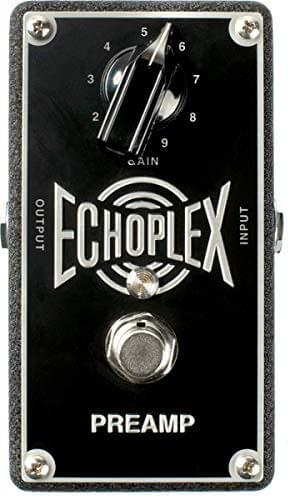
Specifications
- Suitable For: Electric Guitar
- Cab Sim: No
- Controls: Gain
- Power: 9V DC PSU or Battery
- Bypass: True
Jim Dunlop pedals have been used by many famous guitarists for decades now, for their high-quality designs and delicious tones. The original EP-3 tape echo was a popular unit amongst many guitarists, and now they’ve launched the EP101 Echoplex preamp pedal; a single-knob preamp overdrive pedal that replicates the FET circuitry and the iconic gain structure of the original.
The EP101 has just one knob that controls the gain of the circuit, similar to the original. This makes the pedal super easy to use, but that singular knob is also versatile in its uses. With up to +11dB of boost, it can really tighten up your signal and add a lot of grit to it. Its sonic character is much like its inspiration, and it offers a very specific flavor of boost; one that’s been loved by many guitarists.
With its simple and compact all-metal design, this pedal is durable and will easily fit any pedalboard. It’s the kind of pedal that can always stay on, and add some much-needed magic to your tone. It features true hardwire bypass switching, and can be powered by a 9V power supply or a battery.
If you’re looking for a pedal to simulate the classic boost and gain of the Echoplex EP-3, then Dunlop has succeeded in recreating that with the EP101. With just one knob that can really shape your tone in many ways, acting somewhat like a ‘tone conditioner’, this guitar preamp pedal is a worthy addition for guitarists looking for new ways to spice up their tone.
8. Xotic BB Preamp V 1.5 Pedal
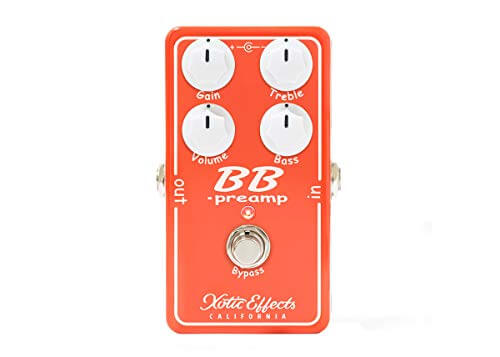
Specifications
- Suitable For: Electric Guitar
- Cab Sim: No
- Controls: Gain, Treble, Volume, Bass
- Power: 9V DC PSU or Battery
- Bypass: True
Xotic effects pedals are known for their remarkable attention to detail, premium design, and great tones. The original Xotic BB guitar preamp was a big success amongst guitarists, and now it has been updated with the BB V 1.5, which is now smaller with a new design, but features the same classic tones.
The BB overdrive preamp has four knobs that control Gain, Treble, Volume, and Bass. The Gain section offers up to +30dB of boost, going from clean boost to crunchy gain and thick sustain. The Treble and Bass controls let you EQ your tone as needed, with +/- 15dB of active boost, proving the BB to be a powerful tone-shaping tool. The Volume knob lets you adjust the overall output volume for a smoother sound.
The new BB V 1.5 is more compact than the original, so it’ll easily fit onto your pedalboard. It has simple mono input and output jacks on the sides. It can be powered by a 9V DC power supply or by a battery, and it has true bypass switching.
If you want a simple analog guitar preamp pedal to act as a boost and EQ, then the Xotic BB V 1.5 preamp is a good option. Its controls are easy to use, it offers a lot of gain with a smooth overdriven sound, it has a 2-band active EQ that works well with electric guitars, and it’s designed with premium componentry.
9. Tech 21 Q\Strip Dual Parametric EQ Instrument DI Pedal
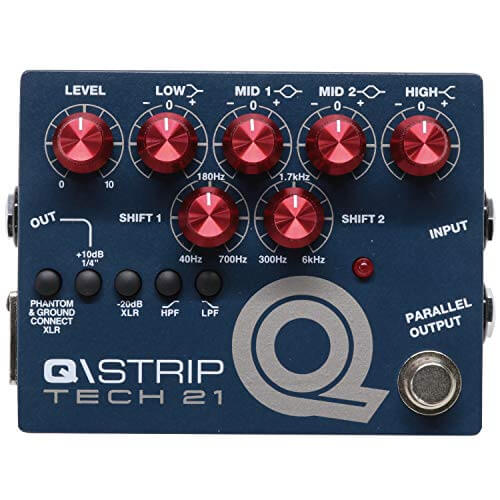
Specifications
- Suitable For: All
- Cab Sim: Yes
- Controls: Level, Low, Mid 1, Mid 2, High, Shift 1, Shift 2, XLR Pad, HPF, LPF
- Power: 9V DC PSU or Battery
- Bypass: Buffered
Tech 21 have made a name for themselves for their innovative analog pedals, guitar effects, amps, and guitar preamps. The Tech 21 Q\Strip is their effort in making a parametric EQ and preamp pedal that simulates the ‘direct-instrument’ sound of analog mixers, much like the Color Box. This pedal features all-analog circuitry, and delivers some crafty tones.
The Q\Strip has a range of control knobs on its front that control the Level, Low, Mid 1, Mid 2, High, Shift 1, and Shift 2. The 4-band EQ, along with the two shift knobs to adjust the centre frequencies, gives you a great amount of control over the sound of the instrument you’re using. There are high-pass and low-pass filters too, to ensure that there’s no harshness or bass rumble in your tone.
The Q\Strip has a fantastic build quality, with an all-metal design, metal knobs, and a compact stompbox chassis. It also features a parallel output jack, a -20dB XLR pad button, a ground connect switch, and +10dB boost. Further, it can act as a cabinet simulator using certain sample settings to mimic the EQ curves of popular cabs. It can be powered by a 9V power supply, or by a battery.
If you want a nice analog preamp with a 4-band EQ that simulates the direct-in sounds of vintage analog gear, the Tech 21 Q\Strip is a fantastic choice. With shiftable midrange frequencies, a range of controls that let you fine-tune your sound, multiple connectivity options, and a rugged design, this pedal is definitely going to find a lot of use both in the studio and live.
What To Know Before Buying a Guitar Preamp Pedal?
Sound
When considering a preamp pedal, the most important characteristic to consider is its sound. All guitar preamp pedals have specific circuitry, whether analog or digital, which determines the tones that they can produce. Since preamps are meant to emulate the sound of amplifiers (such as tube circuits), this is especially important, and most preamps generally have a unique flavor of their own.
Many preamp pedal manufacturers will often state what type of amplifier they have based its tone on (such as a Marshall or a Fender, or a solid-state amp), which can help guide you to the tone you’re looking for. Pedals like the Mooer Preamp Live have dozens of preamps that can be selected, so you have more versatility. Another factor to consider is whether it has a ‘cab sim’ or not .
A cab sim is essentially a simulation of the speaker cabinets used in vintage amps, and is an important part of their characteristic sound.
These cabinets affect the EQ of your tone, and if a preamp doesn’t have a cab sim, it may need to be plugged into a cabinet to sound good. Pedals that allow you to change the cab sim give you even greater versatility, such as the Darkglass Ultra.
The best way to determine a guitar preamp pedal’s sound is to try it out yourself at a local store. But if that’s not possible, try watching demo videos online and see what sounds good to your ears.
Suitability And Controls
Preamp pedals can be suitable for a wide range of instruments, and even for vocals. On this list, we’ve included a range of pedals suitable for electric, acoustic, and bass guitars. Some, such as the Color Box and Q\Strip, are suitable for any kind of instrument. Based on which instrument you plan to use your pedal with, we recommend buying the appropriate one. Sometimes, it’s worth experimenting as well, and seeing what sounds good to you.
Guitar preamp pedals come with a range of different controls. Some have just one knob, while others have a host of controls. Some have EQs built into them, while some may have reverb or compression or other effects. Depending on your current pedalboard setup and your requirements, pick a preamp pedal that’ll fit in nicely with your existing pedals and has the necessary controls and effects to fine-tune your sound to perfection.
Design, Power, and Bypass
Preamp pedals come in a range of shapes and sizes, so it’s important to choose one that’ll be comfortable for you to carry around, and fit in your existing setup. Some are more durable than others too, so keep that in mind. Another important thing to consider is the type of bypass they have, as preamp pedals are often placed either at the end or beginning of the signal chain.
Buffered bypass ensures signal integrity and prevents high-frequency losses, but may cause slight tone coloration.
The type of bypass, whether true or buffered, also depends on the pedals you already have, and their impedances. So it’s a good idea to ensure that there aren’t any mismatches between the pedals, which may cause signal loss or ‘tone-sucking’.
Depending on whether you want to use the pedal portably, running on batteries, or connect it to a power supply, ensure that the pedal receives the correct voltage and current for it to run efficiently. This’ll prevent any unnecessary hum or noise, and bring out the best tone of the preamp pedal.
FAQs
What is a preamp pedal?
A preamp pedal is a stompbox unit that emulates the ‘pre-amp’ section of an amplifier. Amplifiers have a preamp stage, and a power amp stage. A preamp is responsible for the primary gain structure that’s added to your tone, whereas power amps boost the volume. Hence, preamp pedals simulate this gain structure through similar analog circuitry, or even digital chips, to offer you an easy and versatile way to shape your tone.
Where should a preamp pedal go?
A preamp pedal can go in multiple different positions on your signal chain. Some guitar players prefer to keep right at the end, where it’ll then connect to a PA system, while some keep it as the first pedal in the chain, so that the guitar interacts with it first. Some also like to keep it just before the delay and reverb pedals. This position primarily depends on the type of preamp pedal you have, and what kind of tone you’re going for.
Why do I need a preamp for my guitar?
You need a preamp for your guitar to boost, equalize, and shape your tone. Preamps are a part of normal amplifiers, where they add gain to your guitar sound. But preamp pedals can be used as a powerful tone-shaping tool, and can be helpful when amplifiers aren’t available. They can EQ your tone, and even compress it, and may be used to simulate a cabinet. The usefulness of preamp pedals is worth experimenting with, as they can really redefine your tone in new ways.
Is a distortion pedal a preamp?
A distortion pedal may or may not be a preamp. Some distortion pedals just have gain circuits, which add gain to your guitar tone, but they are not a preamp. But some distortion pedals also have EQ, which helps shape the tone, and it may also convert the output signal to ‘line’ level. In such cases, the distortion acts as a preamp.
